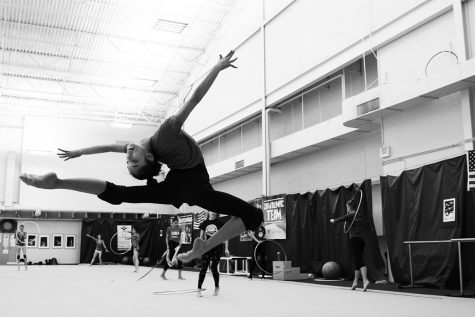National level rhythmic gymnast aims high

In a brief moment of silence before the sounds of the U.S. national anthem filled the 2017 Sofia Cup stadium, junior Lili Mizuno beamed at the top of the podium holding her hand across her heart after winning first place in her hoop event.
“I was smiling so much because in that moment it was just a great feeling to know that I [was representing] the U.S.,” Lili said.
According to Lili, the Sofia Cup, a World Cup for each participating country’s top rhythmic gymnasts, took place in Sofia, Bulgaria in 2017. Rhythmic gymnastics can be performed as an individual or group sport in which gymnasts compete in four main events: hoop, ball, clubs and ribbons. At the Sofia Cup, Lili placed first in her hoop category.
“No one expected [me to win] because international competitions make it so much harder to get on the podium,” said Lili. “[The judges] were shuffling music looking for the U.S. national anthem song because they weren’t expecting the U.S. to win.”
In order to compete at the international level, Lili had to place as one of the top eight rhythmic gymnasts in the country at National Qualifiers. Once gymnasts are placed on the national team, they attend the Rhythmic Challenge Competition. Lili said she placed third in the country overall at the Rhythmic Challenge Competition. Rhythmic gymnastics rankings are determined by adding up the individual scores in each of the four separate categories.
Lili’s coach, Natalia Klimouk, head coach at the North Shore Rhythmic Gymnastics Center, said in a phone interview that Lili has been competing internationally for four years.
Lili said to qualify for the Rhythmic Gymnastics National Team, gymnasts must go through the USA Gymnastics Championships and place among the top 20 gymnasts in the country every year. Once these various local level competitions are over, the 20 chosen qualifiers compete in the National Qualifier from which the top eight rhythmic gymnasts become a part of the Rhythmic Gymnastics National Team.
When Lili is not competing internationally, she is taking five academic classes at Glenbrook North and balancing her time between the gym and catching up on missed work, Lili said.
“American gymnasts here are absolutely from a different world,” said Klimouk. “The strongest [countries for rhythmic gymnastics] like China or Russia, [the girls] have no school. Our girls have school, and they are managing it in an absolutely different way, and I really respect this.”
According to Klimouk, based on Lili’s third place result in the 2018 Rhythmic Challenge Competition, she is scheduled to fly to Russia on April 25 for a five-day training period, and then she plans to compete in the Baku World Cup in Azerbaijan. From there, she plans to travel to the Guadalajara World Challenge Cup in Spain and the Portimao World Challenge Cup in Portugal.
“It’s so nerve-wracking to be able to compare local events to [international competitions],” said Lili. “It used to be when you step [out onto] the carpet, you saw a few bleachers and the parents of gymnasts watching, and [it was not] intimidating. But, once you go to the World Cups, … there’s a whole stadium filled with people and fans screaming [for your country].”
Lili said international competitions can sometimes take up weeks or even month long periods which makes it hard to keep up with school work.
“Sadly most of [my teammates’ and my free time is spent] trying to catch up on school work,” said Lili. “[At the hotels] we all just hang on the beds, get a desk, and take out all our school work and complain to each other about how much [school] we are missing.”
Lili said sometimes she misses having a social life, but she knows there is a trade-off between either having the normal high school experience, or traveling around the world to compete internationally as one of the top rhythmic gymnasts in the United States.
“My goal is to go to the 2020 Tokyo Summer Olympics.
“There have been several times when I wanted to quit because [the national team] just puts me under so much pressure from everyone,” said Lili. “[But then I remember] that rhythmic is part of my soul and I’m doing it because I love it.”

